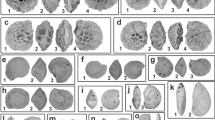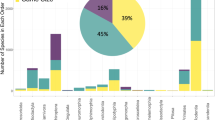Abstract
The ratite moa (Aves; Dinornithiformes) were massive graviportal browsers weighing up to 250 kg (ref. 1) that dominated the New Zealand biota until their extinction approximately 500 yr ago. Despite an extensive Quaternary fossil record, moa taxonomy remains problematic1,2,3,4 and currently 11 species are recognized. Three Dinornis species were found throughout New Zealand and differed markedly in size (1–2 m height at back) and mass (from ∼34 to 242 kg)1. Surprisingly, ancient mitochondrial DNA sequences show that the three species were genetically indistinguishable within each island, but formed separate North and South Island clades. Here we show, using the first sex-linked nuclear sequences from an extinct species, that on each island the three morphological forms actually represent just one species, whose size varied markedly according to sex and habitat. The largest females in this example of extreme reversed sexual size dimorphism were about 280% the weight and 150% the height of the largest males, which is unprecedented among birds and terrestrial mammals. The combination of molecular and palaeontological data highlights the difficulties of analysing extinct groups, even those with detailed fossil records.
This is a preview of subscription content, access via your institution
Access options
Subscribe to this journal
Receive 51 print issues and online access
$199.00 per year
only $3.90 per issue
Buy this article
- Purchase on Springer Link
- Instant access to full article PDF
Prices may be subject to local taxes which are calculated during checkout




Similar content being viewed by others
References
Worthy, T. H. & Holdaway, R. N. The Lost World of the Moa (Indiana Univ. Press, Bloomington, 2002)
Archey, G. The moa: A study of the Dinornithiformes. Bull. Auck. Inst. Mus. 1, 1–144 (1941)
Oliver, W. R. B. The moas of New Zealand and Australia. Dominion Mus. Bull. Well. NZ, 15, 1–204 (1949)
Cracraft, J. Covariation patterns in the post-cranial skeleton of the moas (Aves, Dinornithidae): A factor analytic study. Paleobiology 2, 166–173 (1976)
Owen, R. On the bone of an unknown struthious bird from New Zealand, meeting of November 12, 1839. Proc. Zool. Soc. Lond. 7, 169–171 (1840)
Hutton, F. W. The moas of New Zealand. Trans. Proc. NZ Inst. 24, 93–172 (1892)
Worthy, T. H. Reappraisal of Dinornis (Aves, Dinornithiformes) species—a morphometric analysis. NZ J. Zool. 21, 113–134 (1994)
Cooper, A. et al. Complete mitochondrial genome sequences of two extinct moas clarify ratite evolution. Nature 409, 704–707 (2001)
Cooper, A. & Poinar, H. N. Ancient DNA: Do it right or not at all. Science 289, 1139 (2000)
Shetty, S., Griffin, D. K. & Graves, J. A. M. Comparative painting reveals strong chromosome homology over 80 million years of bird evolution. Chromosome Res. 7, 289–295 (1999)
Huynen, L., Millar, C. D. & Lambert, D. M. A DNA test to sex ratite birds. Mol. Ecol. 11, 851–856 (2002)
Greenwood, A. D., Capelli, C., Possnert, G. & Paabo, S. Nuclear DNA sequences from late Pleistocene megafauna. Mol. Biol. Evol. 16, 1466–1473 (1999)
Davies, S. J. J. F. Ratites and Tinamous (Oxford Univ. Press, Oxford, 2002)
Bertram, B. C. R. Breeding Systems and Strategies of Ostriches 890–894 (Proc. XVII Int. Ornith. Congr., Berlin, 1979)
Marchant, M. & Higgins, P. J. Handbook of Australian, New Zealand and Antarctic Birds (Oxford Univ. Press, Melbourne, 1990)
Worthy, T. H. Sexual dimorphism and temporal variation in the North Island moa species Euryapteryx curtus (Owen) and Pachyornis mappini (Archy). Natl Mus. NZ Rec. 3, 59–70 (1987)
Andersson, M. Sexual Selection (Princeton Univ. Press, 1994)
Atkinson, I. A. E. & Greenwood, R. M. Relationships between moas and plants. NZ J. Ecol. 12, 67–96 (1989)
Shine, R. Ecological causes for the evolution of sexual dimorphism—a review of the evidence. Q. Rev. Biol. 64, 419–461 (1989)
Lewis, K. B., Carter, L. & Davey, F. J. The opening of Cook Strait—interglacial tidal scour and aligning basins at a subduction to transform plate edge. Mar. Geol. 116, 293–312 (1994)
Barnes, I., Matheus, P., Shapiro, B., Jensen, D. & Cooper, A. Dynamics of Pleistocene population extinctions in Beringian brown bears. Science 295, 2267–2270 (2002)
Hjelmqvist, L. et al. Alcohol-dehydrogenase of class-I—kiwi liver-enzyme, parallel evolution in separate vertebrate lines, and correlation with 12s ribosomal-RNA patterns. FEBS Lett. 367, 306–310 (1995)
Drummond, A. J., Nicholls, G. K., Rodrigo, A. G. & Solomon, W. Estimating mutation parameters, population history and genealogy simultaneously from temporally spaced sequence data. Genetics 161, 1307–1320 (2002)
Owen, R. Memoirs on the Extinct Wingless Birds of New Zealand (London, 1879)
Acknowledgements
We thank the Museum of New Zealand Te Papa Tongarewa (A. J. D. Tennyson, J. A. Bartle), Canterbury Museum (P. Scofield), Auckland Museum (B. Gill), Otago Museum (S. Michelsen-Heath), B. Reeve, Bell Hill Vineyard (M. Giesen, S. Veldhuizen), Pampas Poultry (H. Macfie), B. Shapiro, T. Gilbert, R. Holdaway, J. Binladen and T. Brand for samples and assistance with analysis. The Oxford University Museum of Natural History provided laboratory space. We thank NERC (A.C. and M.B.), Wellcome and Leverhulme Trusts (A.C.), BBSRC (T.F., W.H., A.D., A.C.), EPSRC (A.D.), Villum Kann Rasmussen Fonden, Denmark (E.W.) and the New Zealand FoRST (T.H.W.) for financial support.
Author information
Authors and Affiliations
Corresponding author
Ethics declarations
Competing interests
The authors declare that they have no competing financial interests.
Supplementary information
Rights and permissions
About this article
Cite this article
Bunce, M., Worthy, T., Ford, T. et al. Extreme reversed sexual size dimorphism in the extinct New Zealand moa Dinornis. Nature 425, 172–175 (2003). https://doi.org/10.1038/nature01871
Received:
Accepted:
Issue Date:
DOI: https://doi.org/10.1038/nature01871
This article is cited by
-
Molecular exploration of fossil eggshell uncovers hidden lineage of giant extinct bird
Nature Communications (2023)
-
Rapid size change associated with intra-island evolutionary radiation in extinct Caribbean “island-shrews”
BMC Evolutionary Biology (2020)
-
The Gastornis (Aves, Gastornithidae) from the Late Paleocene of Louvois (Marne, France)
Swiss Journal of Palaeontology (2016)
-
Ancient DNA microsatellite analyses of the extinct New Zealand giant moa (Dinornis robustus) identify relatives within a single fossil site
Heredity (2015)
-
Dung beetles in an avian-dominated island ecosystem: feeding and trophic ecology
Oecologia (2014)
Comments
By submitting a comment you agree to abide by our Terms and Community Guidelines. If you find something abusive or that does not comply with our terms or guidelines please flag it as inappropriate.



